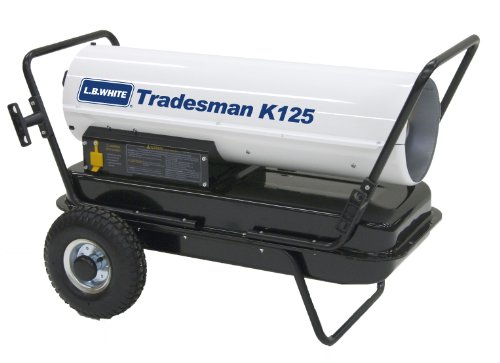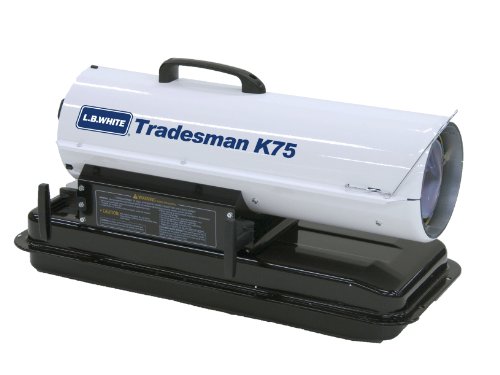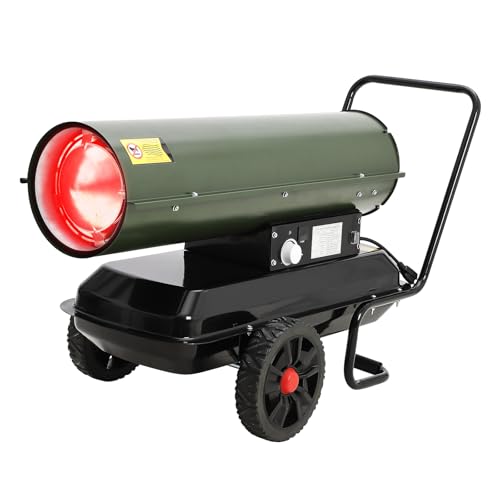Fuel oil torpedo heaters deliver high-output, portable heat where temporary or off-grid warmth is needed. Below is a quick comparison of five widely used models selected for multi-fuel compatibility, build quality, and output range. Read each product summary and the buying guide to match a heater to your jobsite, garage, or workshop needs.
| Model | Brand | Output | Fuel Compatibility |
|---|---|---|---|
| LB White Tradesman K125 | L.B. White | 125,000 BTUH | Kerosene, No.1 diesel, No.1 fuel oil |
| LB White Tradesman K75 | L.B. White | 75,000 BTUH | Kerosene, No.1 diesel, No.1 fuel oil |
| Mr. Heater 80,000 BTU | Mr. Heater | 80,000 BTUH | Kerosene, filtered diesel, fuel oil, Jet A |
| Mr. Heater 185,000 BTU | Mr. Heater | 185,000 BTUH | Kerosene, filtered diesel, fuel oil, Jet A |
| Towallmark 125,000 BTU | Towallmark | 125,000 BTUH | Kerosene, diesel, home heating oil, Jet fuel |
Content Navigation
- LB White Tradesman K125 Heater
- LB White Tradesman K75 Heater
- Mr. Heater 80,000 BTU Forced Air
- Mr. Heater 185,000 BTU Forced Air
- Towallmark 125,000 BTU Torpedo Heater
- Buying Guide
- Heat Output And Space Coverage
- Fuel Compatibility And Availability
- Runtime, Tank Capacity, And Refueling
- Ignition, Controls, And Diagnostics
- Construction Quality And Component Durability
- Safety, Ventilation, And Compliance
- Maintenance And Fuel Treatments
- Portability And Installation
- Operational Costs And Efficiency
- Comparison Perspectives
LB White Tradesman K125 Heater

The LB White Tradesman K125 is a portable forced-air torpedo heater designed for construction, shop, and industrial use. It produces 125,000 BTUH and supports kerosene, No. 1 diesel, and No. 1 fuel oil, giving operators fuel flexibility when natural gas isn’t available.
Key features include a dual-prong electronic spark ignition for dependable starts and a heavy-duty enclosed motor. The heater uses brass fuel fittings rather than plastic to resist wear in harsh conditions. The directional forced-air design is intended to provide instant, effective heat to targeted work areas.
Applications: temporary jobsite heat, garage and workshop spot heating, and outdoor sheltered work zones. Maintenance considerations include proper fuel filtration and periodic inspection of fittings and ignition components.
LB White Tradesman K75 Heater

Call 888-896-7031 for Free Local HVAC Quotes – Compare and Save Today!
The LB White Tradesman K75 is a lower-output sibling to the K125, rated at 75,000 BTUH. It accepts the same fuels—kerosene, No.1 diesel, and No.1 fuel oil—and targets smaller spaces or situations where less heat is needed.
It shares key construction features with larger LB White models, including the dual-prong electronic ignition, an enclosed motor, and durable brass fuel fittings. The lighter output and compact form factor make it suitable for smaller shop areas, partial building work, or supplemental heating on sites with limited ventilation.
Operators should follow manufacturer guidance for clearances and ventilation and ensure fuel compatibility with the unit’s specifications. Routine checks of the ignition system and fuel lines maintain reliable operation.
Mr. Heater 80,000 BTU Forced Air

The Mr. Heater 80,000 BTU Forced Air is a multi-fuel torpedo heater rated at 80,000 BTUH and intended to heat up to about 2,000 sq ft depending on conditions. It is compatible with kerosene, filtered diesel #1/#2, fuel oil #1/#2, and Jet A (JP8).
This model includes a built-in thermostat and LED troubleshooting diagnostics, helping streamline setup and fault identification. The inclusion of diagnostic LEDs supports faster diagnosis of ignition or fuel problems on busy jobsites.
Call 888-896-7031 for Free Local HVAC Quotes – Compare and Save Today!
Best used for medium-sized spaces, emergency heat, or as a supplemental work heater. Fuel filtration and adherence to maintenance schedules are important to preserve burner performance, especially when using varied fuels.
Mr. Heater 185,000 BTU Forced Air

The Mr. Heater 185,000 BTU model delivers 185,000 BTUH and is rated for larger spaces—up to approximately 4,625 sq ft in favorable conditions. It supports the same broad fuel list as other Mr. Heater units: kerosene, filtered diesel, fuel oil, and Jet A.
Features include a built-in thermostat and LED diagnostics to help operators monitor and troubleshoot the unit. The higher heat output suits large open buildings, commercial construction zones, or outdoor covered areas requiring rapid, robust heat.
Given its high output, users should ensure adequate fuel supply, safe placement to maintain required clearances, and appropriate ventilation per local codes and manufacturer instructions.
Towallmark 125,000 BTU Torpedo Heater

The Towallmark 125,000 BTU torpedo heater offers up to 125,000 BTUH and lists compatibility with kerosene, diesel, home heating oil, and jet fuel (manufacturer warning: do not use gasoline). The unit includes a sizable 26L (approx. 6.87 gal) fuel tank for extended run times.
Specifications note up to 8 hours runtime on a full tank under certain conditions. The unit’s physical dimensions and weight indicate a portable but substantial heater intended for jobsite and outdoor use.
Operators should follow the unit’s safety guidance, especially the fuel restrictions and clearance requirements. Fuel capacity and runtime data can be a deciding factor for extended operations where refueling access is limited.
Buying Guide
This guide highlights the primary factors to weigh when choosing a fuel oil torpedo heater. Consider your space, fuel access, ventilation, and maintenance expectations.
Tips for Getting the Best HVAC Prices
- Prioritize Quality Over Cost
The most critical factor in any HVAC project is the quality of the installation. Don’t compromise on contractor expertise just to save money. - Check for Rebates
Always research current rebates and incentives — they can significantly reduce your overall cost. - Compare Multiple Quotes
Request at least three estimates before making your choice. You can click here to get three free quotes from local professionals. These quotes include available rebates and tax credits and automatically exclude unqualified contractors. - Negotiate Smartly
Once you've chosen a contractor, use the proven strategies from our guide — How Homeowners Can Negotiate with HVAC Dealers — to get the best possible final price.
Heat Output And Space Coverage
- Match BTU To Volume: Estimate cubic footage and choose a heater rated to provide sufficient BTUs. Higher BTU models heat larger or leakier spaces faster.
- Multiple Units: For uneven or partitioned spaces, multiple smaller heaters may provide more uniform warmth than one large unit.
Fuel Compatibility And Availability
- Fuel Options: Multi-fuel compatibility (kerosene, diesel, fuel oil, Jet A) increases flexibility when specific fuels are scarce.
- Fuel Quality: Use filtered fuel and consider fuel treatments to prevent gelling, moisture issues, and deposit buildup in tanks and burners.
Runtime, Tank Capacity, And Refueling
- Tank Size: Larger tanks extend run time but increase weight. Assess refueling logistics on remote jobsites.
- Run Time Estimates: Manufacturer runtime estimates vary by output setting and ambient conditions; plan conservative fuel needs.
Ignition, Controls, And Diagnostics
- Reliable Ignition: Electronic spark ignition systems ease starts in cold conditions.
- Thermostat And Diagnostics: Built-in thermostats and LED diagnostics simplify operation and troubleshooting during busy work shifts.
Construction Quality And Component Durability
- Fuel Fittings: Brass fittings resist corrosion and wear better than plastic connectors in demanding environments.
- Motor Enclosure: Enclosed, heavy-duty motors increase longevity in dusty or rough jobsite conditions.
Safety, Ventilation, And Compliance
- Ventilation: Forced-air torpedo heaters exhaust combustion products; ensure adequate ventilation per manufacturer guidance and local codes.
- Clearances And Placement: Maintain required clearances from combustibles and avoid using indoors in poorly ventilated occupied spaces.
- Fuel Handling Safety: Use approved containers and grounding procedures as applicable, and follow spill containment best practices.
Maintenance And Fuel Treatments
- Routine Checks: Inspect ignition components, fuel lines, and filters regularly to prevent failures.
- Fuel Additives: Consider products that address waxing, water, and sludge to maintain burner efficiency and reduce soot.
Portability And Installation
- Weight And Handles: Choose models with suitable weight and lift points for your crew to move safely.
- Mounting And Positioning: Many torpedo heaters are free-standing; confirm stable placement and vibration isolation where needed.
Operational Costs And Efficiency
- Fuel Efficiency: Higher-efficiency burners reduce fuel consumption but review actual on-the-job fuel use rather than only rated efficiency.
- Indirect Costs: Consider maintenance, filter replacement, and downtime when comparing models.
Comparison Perspectives
- Small-to-Medium Spaces: Models in the 75k–125k BTU range (LB White K75/K125, Towallmark 125k) balance portability and output for garages and moderate jobsite areas.
- Medium-to-Large Spaces: 185k BTU units provide rapid heat for larger buildings or open-work environments where ventilation and clearance are manageable.
- Diagnostics And Controls: Units with thermostats and LED diagnostics (Mr. Heater models) can reduce setup time and simplify troubleshooting in busy operations.
- Durability: Models with brass fittings and enclosed motors (LB White line) emphasize long-term reliability under harsh conditions.
